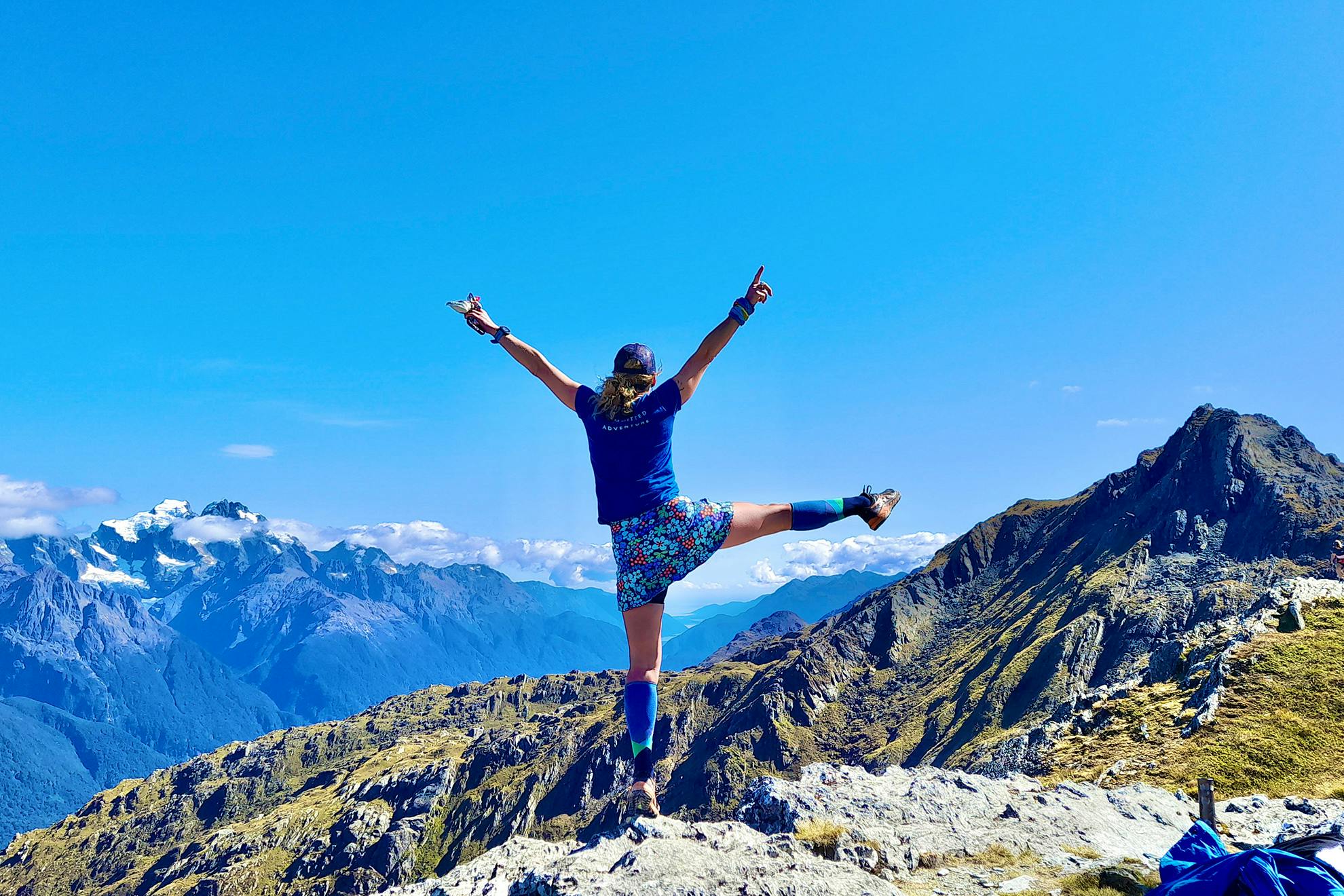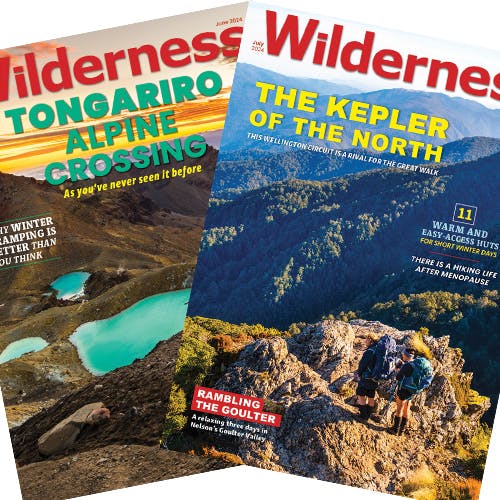Perimenopause can be a difficult time for women, and some may find they no longer enjoy spending time in the outdoors. These women suggest ways to maintain your tramping mojo.
I stood at the edge of Red Crater, bleeding furiously, gripped by pain that felt like twisted barbed wire as violent lightning ripped through my abdomen.
I was guiding clients on the Tongariro Alpine Crossing at the time. I shepherded them up and over, pointed out the views of the Kaimanawa Range and hoped they hadn’t noticed my state and I thought: “I’m done. I’m done with this.”
And so I kicked off 2024 with a hysterectomy and learned that the pain wasn’t all in my head, as one doctor after another had told me. It was stage three endometriosis and a selection of other issues. Turns out a hysterectomy can be less painful than having a period.
The surgeon didn’t remove my ovaries (known as an ‘oopherectomy’, it is not in fact part of a hysterectomy), but he did warn me that even with ovaries in place, the hysterectomy would likely bring on early menopause.
I was sick of hearing about menopause. I knew the list of potential adverse symptoms, which contained everything from insomnia to night sweats, hot flushes, joint pain, brain fog, mood changes, weight gain and an impending sense of doom. Menopause is everywhere these days along with narratives I find depressingly negative. “It sucks all the goodness out of us,” one person told me. And: “You’ll lose all your muscle.” Further: “There’s no point trying to do anything any more because your strength and ability is totally gone.”
This didn’t tally with my experience: post-menopausal friends running ultramarathons and achieving big climbing goals, outdoorsy women who are more badass than ever before. One friend had become leaner and fitter than I’d ever seen her, slaying the hot flushes with her perimenopausal ninja scissorhands. Was I really supposed to just give up and go sit in a corner?
A year earlier I’d messaged Caroline Webbon, a well-known tramper who’s also a personal trainer, to ask her that very question. Her answer, along with some other salient advice such as the importance of strength training, nutrition and consistency, stuck with me: “F*** it, and fight on.”

Later on, Webbon posted on a tramping Facebook group about losing her tramping mojo thanks to perimenopause. Her post-trip recovery was becoming tough and she felt constantly exhausted. Her anxiety shot up, and fear that her body couldn’t cope any more took over.
She received many messages of support, thanking her for raising the issue and sharing her experiences.
“Many women are suffering,” Webbon says “A lot of people have thanked me for opening up conversation about a taboo topic.”
Her main symptoms were intense fatigue with a long recovery time, sleep issues, low mood, high anxiety and “a general lack of enthusiasm for life”.
“The thought of sorting out logistics for hiking, let alone the actual event itself, just filled me with dread, so I stopped,” she says. “I was just tired. Too tired all the time.”
Webbon assumed that, because she was over 50, her zest for life had gone. Finished. Then one day it changed. “I realised I wasn’t sailing through menopause and needed to put myself first. There are a lot of positive lifestyle choices we can make – sleep, exercise, nutrition, meditation, mindfulness and nature – that’s the starting point. Then investigate homeopathic remedies, adaptogens for support and menopause hormone therapy. There isn’t a one-size-fits-all method. Every woman is different, with different symptoms.”
Jo Morgan is known as the ’granny mountaineer’, taking up mountaineering when she was 57, and summiting 22 of the country’s 3000m-plus mountains. I’d met Morgan before, so asked her for advice. She admitted to being fairly trouble free with menopause. She’d heard of perimenopause only recently.

“My periods stopped around 55, and it was such a relief,” Morgan says. “I had menstruated on every continent by then and ruined knickers and sheets the world over. I hated the inconvenience but had not been too sick or pained by it. The year or so I had off for each of my four pregnancies was wonderful.”
Morgan encountered hot moments in her 50s – she flung off clothing and bedding – and the power surges continued on and off until her mid-60s. But she put a positive spin on it: “It was amazing. In freezing cold bivvies in the mountains I lay down and was immediately lovely and warm.”
Her attitude inspired me.
“The muscle and strength loss from the mid-60s is very frustrating,” Morgan says. She recommends that women work hard to maintain and build muscle, and minimise sugary foods and drinks. Choose to socialise in an active way, such as by going for a walk, a coffee, or hike and picnic.

I’d also tramped with Wilderness contributor Jo Stilwell, who has completed many admirable backcountry trips. I’d long admired her resilience, fitness and enthusiasm. She’s 54 and has told me that she’d never considered menopause would prevent her tramping.
“Since menopause, I’m stronger, fitter and feel the best I’ve felt for years,” she says. “But is this because of menopause? Probably not. My husband has the same goals as I do – to keep fit and strong with the aim of spending as much time in the outdoors as possible. You could say we are quite boring – eating well, limiting alcohol, getting lots of sleep, doing strength and mobility work – all for the sole purpose of being able to tramp for many years to come.”
About 18 months ago Stilwell started strength training as she’d begun to find it challenging to build muscle. She wishes she’d done this years ago as it’s made a huge difference to her tramping fitness.
She also started hormone replacement therapy (HRT) after realising menopause symptoms – notably, hot flushes and bad sleep – had become regular features. Joint pain and nausea also made tramping harder, but HRT provided relief.
And Stilwell admits to advantages from menopause: “It’s wonderful not having to deal with periods while in the outdoors – not feeling sick from period pain, or needing to deal with heavy bleeding and period products.
“My number one tip for ageing women who want to keep tramping would be to start strength training – the earlier the better. And try HRT – again, the earlier the better.”

I also admire tramper and runner Rosie Roams, who has run several ultramarathons including the ‘miler’ (160km) at the Tarawera Ultra event. Roams echoed the benefits of HRT saying she regretted not starting earlier. She had a hysterectomy 10 years ago amid what she described as “a complicated medical history”.
“My life is much better now,” Roams says. “There was fear-mongering about HRT, and it’s been debunked.”
She does admit though that menopause was hard to navigate.
“The compass I’d used to find my true north seemed to be sending me on a path that had me confused and fatigued, like being lost in the mountains with no cell phone service and a PLB with a flat battery.”
As an endurance athlete, Roams ate mountains for breakfast.
“Strong in body and mind, I’d muscled my way through having five babies while maintaining endurance, fitness, strength, confidence, and energy for living life that people often said they wanted to bottle.
“I’ve often thought of my body as my strong castle. Menopause brought that castle crumbling down on top of my strong foundations.”
Help came from natural hormone replacement therapy, and HRT has been the mortar that’s helped the castle rebuild.
“Be patient with yourself,” Webbon says. “Focus on getting your symptoms and hormones under control first. Once you see some changes in how you feel, you’re more inclined to start doing the things you used to love. Make the decision to do something, train for it and just do it. It might feel overwhelming at the time, but if you loved tramping before menopause, once your symptoms are better managed, your love for tramping will still be there, and you’ll want to do more and more.”

Post-menopause, Morgan is still living life large. “I still do headstands, ride motorbikes, climb trees and mow lawns,” she says. “As well, a fantastic sex life is not only possible but actually quite common in your 60s.”
Stilwell says fitness is a game changer: “I’m pretty driven and work hard at maintaining my fitness so that tramping can be more enjoyable.
“Every decade has been better than the one before. I hear stories of women losing confidence after menopause, but for me, every year is better than the last. That’s also about feeling happier and more content with myself as I age. I’m putting effort and energy into controlling the things I can, which will hopefully help me as I age. I’m fitter and stronger than I’ve ever been. It feels quite exciting, actually.”
Roams echoes that positivity. “If the ground feels shaky, I encourage you to seek help. There’s a tremendous life after menopause, mountains to climb, and adventure abounds. Get amongst it!”
The advice from these women stayed with me as I recovered from my hysterectomy. I focused first on simply walking again, just slow and flat stuff to start. (My surgeon said I could tramp again at the four-week mark, but his eyes widened when I described what ‘tramping’ looks like for me, and he revised that to six weeks.) After three months, I started strength training pretty hard, and was back guiding before winter conditions hit.
The lack of endometriosis pain and iron deficiency-inducing bleeding has been a real treat. I realise now that menopausal symptoms had been with me for many years but were masked by the more agonising effects of endo.
As I stood at the edge of Red Crater recently, Webbon’s words echoed in my head: “F*** it, and fight on.”








